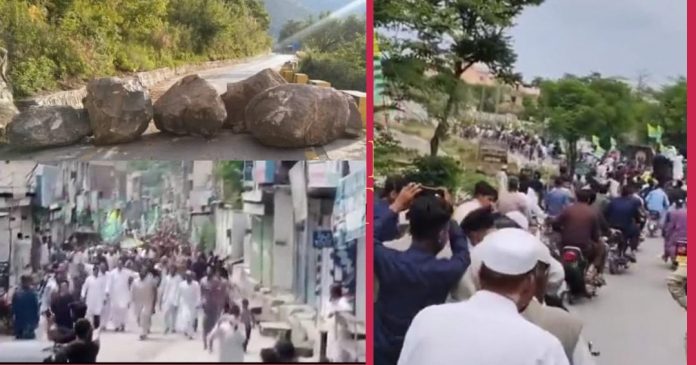Pakistan occupied Jammu and Kashmir (POJK) witnessed a tumultuous turn of events on May 11 as tensions between the Pak FC forces and protestors reached a boiling point.
The FC forces initiated a crackdown on protestors, resorting to tactics such as gunfire, tear gas shelling, and stone pelting, leaving dozens injured.
According to reports, in Mirpur, FC personnel disguised in civilian attire aggravated the situation, inciting the mob towards violent actions. As a result of the clashes, more than 60 Kashmiri protestors. Additionally, around 50 FC personnel were injured during the confrontation.
In few instances, the FC forces were beaten and chased while they trie to flee from the clutches of agitated protestors, who turned violent after Pak lawlessness.
The situation became out if control as people started confronting Pak forces with some picture emerging of Pakistan FC forces caught and made to leave their uniform which social media took as a reminiscent of 1971. Additionally an FC personal was thrown from the cliff.
In solidarity with the people of POJK, a rally was taken out by the Awami Action Committe of Pal occupied Gilgit-Baltistan (POGB) from Palace Hotel to Ittehad Chowk in Gilgit city. They protested the arrest of the leaders of POJK Awami Action Committe.
Meanwhile, the processions from across POJK started moving towards Muzaffarabad on May 11 but faced road blocks as many roads towards Muzaffarabad were blocked by GC forces.
Slogans of “Hum leke rahenge azaadi, him chheen ke lenge azaadi” were raised across POJK.
Awami Action Committe Chairman warns Pak forces
The Awami Action Committe chairman Shaukat Nawaz Mir vehemently condemned the Pak brutality and warned that any further arrest would lead to a direct confrontation.
Notably, these protests started by the J&K Joint Awami Action Committee a year ago, demanding the subsidised wheat, electric power, royalty on the power generated from Kashmiri resources, among others.
What are the protests actually for?
The Awami Action Committee had issued a Charter of Demands highlighting its course of action and demands.
In the course of one year, POJK saw women’s protest, children protest, complete shutdown, school students’ protest but Pakistan remained unmoved by the ordeal of protestors, who were out on road in chilling winters.
Due to high inflation, the prices of wheat flour have gone up unprecedentedly. Kashmiris are demanding subsidised wheat as provisioned for the disputed land under the UN Charter.
This must be understood here that POJK is not the fifth state of Pakistan and hence Pak denies to treat the people as its citizen. However, it earns massively from the region, without giving Kashmiris their due share. The region generates 4900 megawatts of electricity and 13 billion units, suffice enough to fulfill the need of entire Pakistan. But that electricity is transmitted to Pakistan and then again sold to POJK at a hefty price which is above Rs. 16 per unit.
To even worse, the Pak authorities do load shedding for over 15 hours a day. To protest against it the protestors have boycotted the electricity bill. Every month they collect the bills and burn them publicly, sometimes take out its death procession, sometimes make paper boats using them to register their symbolic protests.
The chaos and violence was unpredicted because the protest has been peaceful since one year. It is the Pak forces that took the region under seize and Muzaffarabad as hostage. The oppression and military control over the already downtrodden population led to violent resistance.

